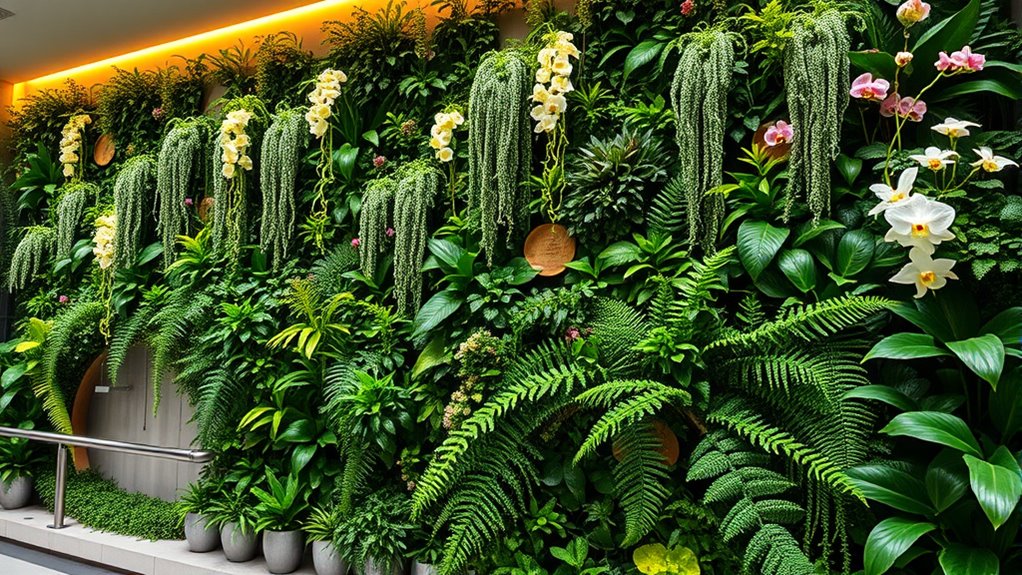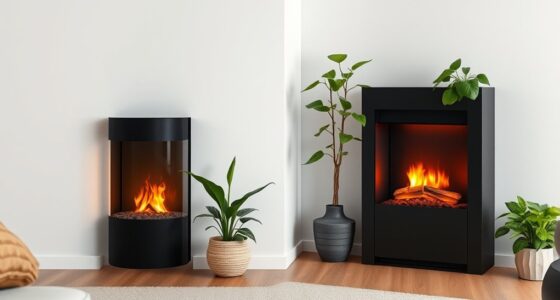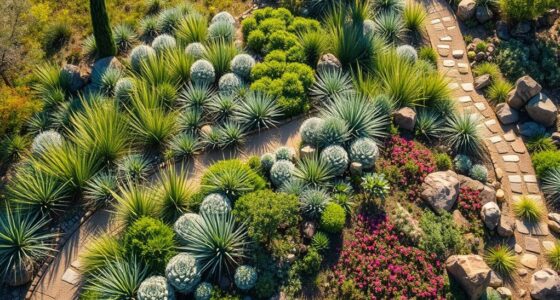Indoor vertical gardens and living walls add striking, sustainable beauty to luxury spaces, transforming bare walls into lush, vibrant gardens. You can create a calming green oasis while showcasing eco-conscious design. These systems reduce mess, pests, and maintenance with smart hydroponic technology, making plant care easier. They also improve air quality and offer a luxurious, nature-inspired atmosphere. Keep exploring to discover how you can incorporate these stunning features into your own space.
Key Takeaways
- Transform blank walls into vibrant, eco-friendly art that enhances luxury interiors and promotes sustainability.
- Use hydroponic systems for clean, low-maintenance plant growth tailored to indoor spaces.
- Improve air quality and create a lush, calming environment with carefully curated plant selections.
- Integrate smart systems for effortless maintenance, making vertical gardens accessible for busy lifestyles.
- Showcase a statement of sophistication and environmental responsibility in modern, upscale settings.

Have you ever considered transforming a blank wall into a lush, green oasis? Indoor vertical gardens make it possible to turn empty spaces into vibrant, living works of art. These installations aren’t just beautiful; they’re a statement of sustainability and luxury. To succeed, understanding the role of hydroponic systems and plant maintenance is essential. Hydroponic systems allow you to grow plants without soil, using nutrient-rich water solutions that are easy to control and customize. This method reduces mess, minimizes pests, and ensures plants receive precisely what they need to thrive. When installing an indoor vertical garden, you’ll want to select a system that fits your space and aesthetic. Some systems use modular panels, while others rely on trays or pockets to hold plants securely. With hydroponics, watering is automated or simplified, making it easier to maintain your garden without constant attention. This ease of plant maintenance makes vertical gardens practical for busy lifestyles or those new to gardening.
Once your system is in place, regular plant maintenance becomes your primary focus. This involves monitoring nutrient levels, ensuring proper lighting, and pruning or replacing plants as needed. Consistent care keeps your garden healthy and vibrant, preventing issues like nutrient deficiencies or disease. A well-maintained vertical garden can flourish for years, adding a touch of nature to any luxury space. It also encourages a deeper connection to the environment, reminding you of the importance of sustainability in modern living. The beauty of indoor vertical gardens lies in their adaptability—they can be designed to suit small apartments, expansive lobbies, or even office spaces. By choosing the right plants and maintaining them properly, you create a dynamic display that enhances your environment and impresses visitors.
Furthermore, the integration of hydroponic systems simplifies maintenance routines, making it easier to keep your garden lush and thriving. You’ll find that once you understand the basics of plant maintenance—such as monitoring water pH, adjusting nutrient concentrations, and ensuring adequate lighting—your garden becomes a manageable part of your daily life. The combination of innovative technology and attentive care transforms a simple wall into a thriving ecosystem. Additionally, utilizing nutritional content from the plants can further enhance your indoor environment by contributing to better health and air quality. Whether for aesthetic appeal, air purification, or sustainable living, indoor vertical gardens elevate any space into a luxurious, eco-friendly retreat. With a little effort and knowledge about hydroponic systems and plant maintenance, you’ll enjoy a stunning, green sanctuary that’s both stylish and sustainable.
Frequently Asked Questions
How Do Indoor Vertical Gardens Impact Indoor Air Quality Long-Term?
Indoor vertical gardens improve your air quality long-term by naturally purifying the air and regulating humidity. As you incorporate these living walls, they actively filter pollutants and VOCs, enhancing air purification. They also help maintain ideal humidity levels, reducing dryness or excess moisture. Over time, this creates a healthier, more comfortable environment, supporting your well-being while adding a stunning, sustainable feature to your luxury space.
What Are the Maintenance Requirements for Living Walls in Luxury Spaces?
Maintaining living walls is like tending a lush, vibrant garden. You’ll need to regularly prune plants to keep them healthy and visually appealing. An efficient irrigation system reduces manual watering, but you should still monitor it to prevent over- or under-watering. Periodic fertilization and pest checks are essential, and occasional soil refreshes help sustain growth, ensuring your luxurious living wall remains a stunning, eco-friendly feature for years to come.
Can Vertical Gardens Be Customized to Fit Specific Interior Designs?
Yes, vertical gardens can be customized to fit your specific interior design. You choose from various material options like metal, wood, or composite panels to match your aesthetic. Custom design allows you to select plant types, layout, and structure, ensuring the living wall complements your space perfectly. This flexibility guarantees that your vertical garden enhances your interior while reflecting your personal style and luxury taste.
Are There Any Health Considerations or Allergies Related to Living Wall Plants?
Living wall plants can sometimes be a source of plant allergies, making you sneeze or itch if you’re sensitive. You should be cautious, as some plants could be toxic or trigger allergic reactions. Think of it as walking through a lush jungle—beautiful but potentially dangerous if you’re allergic. Always check for allergenic or toxic plants beforehand, and choose hypoallergenic options to enjoy the greenery safely and healthily.
What Is the Typical Lifespan of an Indoor Vertical Garden System?
Your indoor vertical garden system typically lasts between 5 to 10 years, depending on factors like plant selection and maintenance. Regularly checking and maintaining the irrigation systems prevents issues like root rot or dehydration. Choosing hardy, low-maintenance plants can extend your system’s lifespan. Proper care, including timely replacement of components and adjusting irrigation, guarantees your living wall remains vibrant and healthy for years to come.
Conclusion
Incorporating indoor vertical gardens transforms spaces into stunning sanctuaries, blending beauty with sustainability. By embracing these bold, biophilic boundaries, you elevate elegance while nurturing nature’s nuances. Let lush layers lend luxury, liveliness, and a lasting legacy of environmental empathy. As you pursue perfection in your space, remember that these living walls not only create mesmerizing charisma but also cultivate a conscious, conscientious commitment to conserving our common climate.









